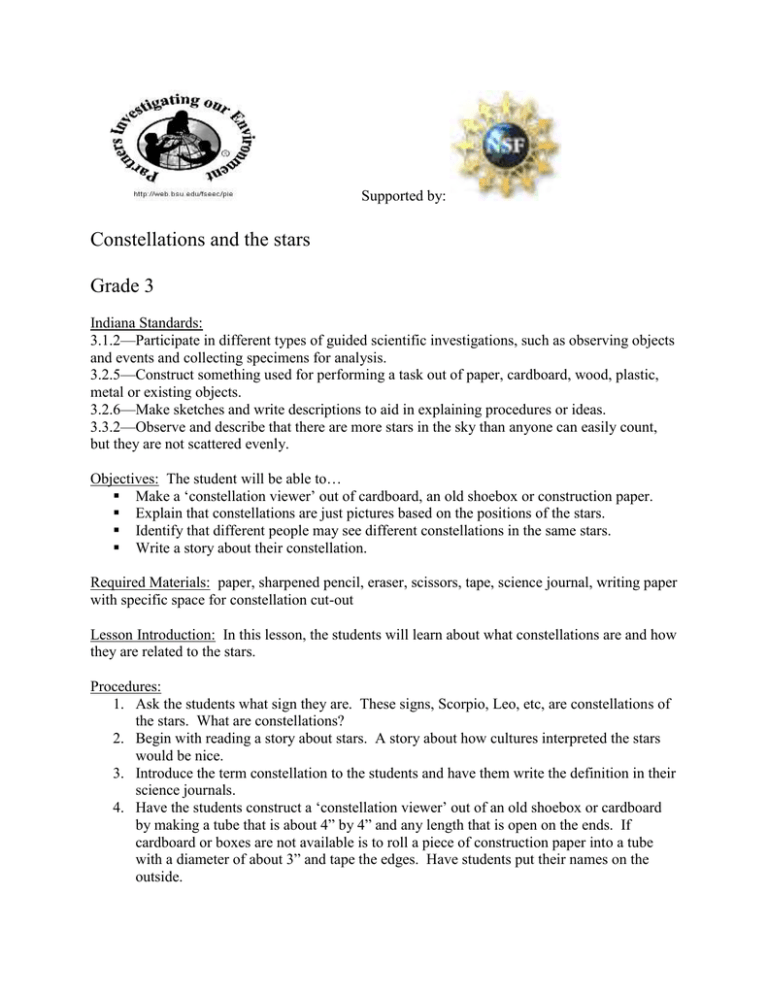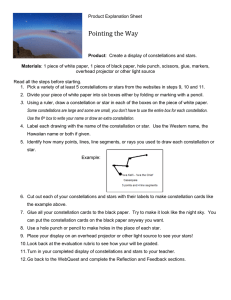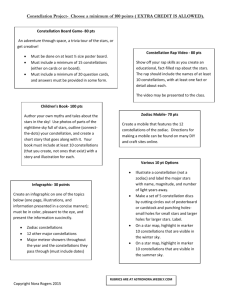Constellations and the stars Grade 3
advertisement

Supported by: Constellations and the stars Grade 3 Indiana Standards: 3.1.2—Participate in different types of guided scientific investigations, such as observing objects and events and collecting specimens for analysis. 3.2.5—Construct something used for performing a task out of paper, cardboard, wood, plastic, metal or existing objects. 3.2.6—Make sketches and write descriptions to aid in explaining procedures or ideas. 3.3.2—Observe and describe that there are more stars in the sky than anyone can easily count, but they are not scattered evenly. Objectives: The student will be able to… Make a ‘constellation viewer’ out of cardboard, an old shoebox or construction paper. Explain that constellations are just pictures based on the positions of the stars. Identify that different people may see different constellations in the same stars. Write a story about their constellation. Required Materials: paper, sharpened pencil, eraser, scissors, tape, science journal, writing paper with specific space for constellation cut-out Lesson Introduction: In this lesson, the students will learn about what constellations are and how they are related to the stars. Procedures: 1. Ask the students what sign they are. These signs, Scorpio, Leo, etc, are constellations of the stars. What are constellations? 2. Begin with reading a story about stars. A story about how cultures interpreted the stars would be nice. 3. Introduce the term constellation to the students and have them write the definition in their science journals. 4. Have the students construct a ‘constellation viewer’ out of an old shoebox or cardboard by making a tube that is about 4” by 4” and any length that is open on the ends. If cardboard or boxes are not available is to roll a piece of construction paper into a tube with a diameter of about 3” and tape the edges. Have students put their names on the outside. 5. Give the students a piece of paper that either has a 4” by 4” square or a 3” diameter circle drawn on it. 6. Tell them to draw a picture of their favorite animal in the square/circle and put a labeled copy of their drawing in their science journal. 7. Now have them take their sharpened pencil and poke ten small holes along the lines of their drawing. Holes at points where lines come together would be good. Have the students put stars on their journal drawing indicating where they punched their holes. 8. Erase drawing on paper. 9. Have students tape drawing to ‘constellation viewer’ so that the drawing would be on the inside. 10. Have students look through their view at the lights. What do the holes look like? Are they like stars at night? Can you connect the holes in your mind to make the constellation that you drew? 11. Instruct students to not tell anyone what your constellation is. Trade ‘constellation viewers’ with someone. Look through it and draw the pattern of the stars in your science journal and label it with the other student’s name. What does it look like? Try to guess what the constellation is and write down your guess in you science journal. 12. Trade again, repeat procedure 9. 13. Explain that our constellations are not the same as the constellations that cultures have developed, so it is alright have a different answer then the maker. 14. Instruct students to write a rough-draft of their story about their constellation. 15. Have students take their constellation off their viewer and use a marker to copy dots onto their final writing paper. Have students redraw their constellation with a light pencil just enough to be seen. 16. Students will write final draft of story. Closure: Talk about how different cultures view the stars differently then we do. More specifically, different cultures do not use the constellations that we do. Assessment: The teacher will… Check student journals for completeness and accuracy. Observe students as they construct constellation viewer. Grade their stories. Extensions: If a star displayer is available, have the students use their constellation viewer to isolate a group of stars and draw what they see in the group. Then show them the constellations that we use in the United States. Written by: Dustan Smith, PIE Fellow, Ball State University



